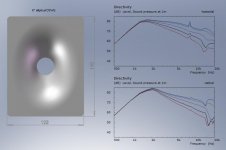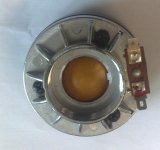JBL has elliptical OS WG on it's cheaper studio monitors. No bueno in this situation, but there may be other issues I don't understand in the design. The thing that stands out in my mind is that they lack dynamics and the treble just sounds "mushy" for lack of a better word. Maybe it's the dome or some other issue with the specific system I heard? They were facing straight into the room.........

Features quote from BHPhoto:
"Clear Treble
The 1" silk dome tweeter has an Elliptical Oblate Spheroidal (EOS) wave guide to ensure that combined and reflected sound mix properly for neutral and accurate sound reproduction"
BTW, I'm not knocking this speaker, just giving an impression of what I heard.
Dan

Features quote from BHPhoto:
"Clear Treble
The 1" silk dome tweeter has an Elliptical Oblate Spheroidal (EOS) wave guide to ensure that combined and reflected sound mix properly for neutral and accurate sound reproduction"
BTW, I'm not knocking this speaker, just giving an impression of what I heard.
Dan
JBL has elliptical OS WG on it's cheaper studio monitors.
BTW, I'm not knocking this speaker, just giving an impression of what I heard.
Dan
There is no similarity between that speaker and what I do except the rip-off of the use of the term "Oblate-Spheriodal"
Are there plans in the works for an EOS? If so any measurements?
EOS is a trade name, not a real thing, There is no "Elliptical Oblate Spheriodal" coordinate system. JBL made it up. And they didn't acknowledge where the ideal came from
I have a mold for a true elliptical OS based design. But I haven't had the time to actually make one.
A friend of mine needs 6" EOSWG as a replacement for Klipsh tweeters:
Klipsch Tweeters | Critesspeakers.com
I'm collecting order list now. Throat is 1".
Klipsch Tweeters | Critesspeakers.com
I'm collecting order list now. Throat is 1".
Attachments
As for the JBLs - Klein&Hummel has used this kind of waveguide design for over a decade now.
Klein&Hummel O110 (as their smallest speaker)
Here're the directivity plots
Source: KLEIN + HUMMEL, O 110 - Active Studio Monitor
I don't know if the Klein&Hummel O500 has been mentioned in this thread before?
Klein&Hummel O110 (as their smallest speaker)
An externally hosted image should be here but it was not working when we last tested it.
Here're the directivity plots
An externally hosted image should be here but it was not working when we last tested it.
An externally hosted image should be here but it was not working when we last tested it.
Source: KLEIN + HUMMEL, O 110 - Active Studio Monitor
I don't know if the Klein&Hummel O500 has been mentioned in this thread before?
An externally hosted image should be here but it was not working when we last tested it.
Does not look like the WG is doing anything
Why? Here is the same but normalized:
http://www.diyaudio.com/forums/multi-way/103872-geddes-waveguides-387.html#post2082665
(first from the top)
EOS is a trade name, not a real thing, There is no "Elliptical Oblate Spheriodal" coordinate system. JBL made it up. And they didn't acknowledge where the ideal came from.
I have a mold for a true elliptical OS based design. But I haven't had the time to actually make one.
I can understand your attitude on this but in truth your wave guide could be characterized as a circular OS wave guide. That is, you use an axial contour that is defined by the surface of an oblate spheroid and then rotate it about the axis of the WG with no azimuthal variation so as to have a constant exit angle. An elliptic contour, as I see it, would just be one defined by making the mouth elliptic instead of circular and having an exit angle which varies with azimuthal position. There is no limitation in defining a coordinate system in either way. The mouth could be shaped in any fashion, even like a dumbbell and a legitimate coordinate system be so defined.
Still, I feel your pain. You patented the device. Perhaps you should have also (if you didn't) trademarked the name. But we all know who is mister OS WG.
John K: I am coming from a slightly different perspective (not a legal one...).
The term waveguide has been around for decades. The names of mathematical functions have been around for even longer.
Do you really think we should try and "own" and restrict these terms?
Again, this is not a legal perspective.
-Tom
The term waveguide has been around for decades. The names of mathematical functions have been around for even longer.
Do you really think we should try and "own" and restrict these terms?
Again, this is not a legal perspective.
-Tom
I can understand your attitude on this but in truth your wave guide could be characterized as a circular OS wave guide. That is, you use an axial contour that is defined by the surface of an oblate spheroid and then rotate it about the axis of the WG with no azimuthal variation so as to have a constant exit angle. An elliptic contour, as I see it, would just be one defined by making the mouth elliptic instead of circular and having an exit angle which varies with azimuthal position. There is no limitation in defining a coordinate system in either way. The mouth could be shaped in any fashion, even like a dumbbell and a legitimate coordinate system be so defined.
Still, I feel your pain. You patented the device. Perhaps you should have also (if you didn't) trademarked the name. But we all know who is mister OS WG.
John
You don't quite have it correct. The Oblate Spheriodal Coordinate system is not something that I did. It is one of the eleven coordinate system in which the wave equation is seperable, i.e. solvable as seperate functions in each coordiante direction. The EOS as youand JBL have defined IS NOT one of the 11 coordinate systems and as such there is no wave propagation that does not couple all there coordinates. Is this a bad thing? Hard to tell. It does mean that you cannot solve the equations analytically, nor can you prove that it has a minimum of HOM generation.
There is an ellipsoidal coordinate system, but this has an elliptical throa as well as mouth, but it is exact.
The OS waveguide was never patented. Curiously enough, it was licesensed by JBL way back when I used to work with John Eargle. They had an option on the rights by paying for the patent proscecusion. Through a long involved mistake, they backed out and I dropped the application, so it was never issued.
Hello earl.
Could you plase explain what is shown in this grafic I cant read it?
Could you plase explain what is shown in this grafic I cant read it?
An externally hosted image should be here but it was not working when we last tested it.
Hello earl.
Could you plase explain what is shown in this grafic I cant read it?
The X axis is frequency and the Y axis is angle. The colors designate the sound level in dB - each contour line is a 3 dB change. Red is the highest and purple the lowest level. This "map" shows how the sound is sent out from the loudspeaker in a single plane - horiziontal in this case, at all frequencies and all locations.
Read the paper on my site about polar maps http://www.gedlee.com/downloads/directivity.pdf. It explains what they are and what to look for.
Last edited:
So what you are saying Dr. Geddes is that JBL is just referring to the shape of the mouth?
They coined a term that sounded good. It doesn't have to mean anything.
John
You don't quite have it correct. The Oblate Spheriodal Coordinate system is not something that I did. It is one of the eleven coordinate system in which the wave equation is seperable, i.e. solvable as seperate functions in each coordiante direction. The EOS as you and JBL have defined IS NOT one of the 11 coordinate systems and as such there is no wave propagation that does not couple all there coordinates. Is this a bad thing? Hard to tell. It does mean that you cannot solve the equations analytically, nor can you prove that it has a minimum of HOM generation.
There is an ellipsoidal coordinate system, but this has an elliptical throa as well as mouth, but it is exact.
The OS waveguide was never patented. Curiously enough, it was licesensed by JBL way back when I used to work with John Eargle. They had an option on the rights by paying for the patent proscecusion. Through a long involved mistake, they backed out and I dropped the application, so it was never issued.
Well what you are saying explains what you were referring to a little better. You really were not talking about a coordinater system, but rather the properties of the wave function in that coordinater system.
These look like sims and the first one does seem to be doing somthing.
But here, if you are using AxiDriver to sim verical and horizontal angles independently, you will not get correct results simply because volume expansion.Why? Here is the same but normalized:
http://www.diyaudio.com/forums/multi-way/103872-geddes-waveguides-387.html#post2082665
(first from the top)
Characteristic of an OSWG is usually the curves closer to axis are more closely spaced than the curves further from axis. In the data of EOSWG you presented does not show this characteristic.A friend of mine needs 6" EOSWG as a replacement for Klipsh tweeters:
Klipsch Tweeters | Critesspeakers.com
I'm collecting order list now. Throat is 1".
Does not look like the WG is doing anything
Well what you are saying explains what you were referring to a little better. You really were not talking about a coordinater system, but rather the properties of the wave function in that coordinater system.
Yes perhaps, but are the two things seperable? (Pun intended)
Soongsc and Earl,
I think I don't understand cut off frequency. Why short diffraction waveguides like Seas DXT or smooth Klein Hummel O 500C do not limit driver bandwidth (low end)? For example can I have 7" waveguide for 2" or 3" dome that could be crossed at 50-600Hz? KH uses 12".
I think I don't understand cut off frequency. Why short diffraction waveguides like Seas DXT or smooth Klein Hummel O 500C do not limit driver bandwidth (low end)? For example can I have 7" waveguide for 2" or 3" dome that could be crossed at 50-600Hz? KH uses 12".
- Home
- Loudspeakers
- Multi-Way
- Geddes on Waveguides

